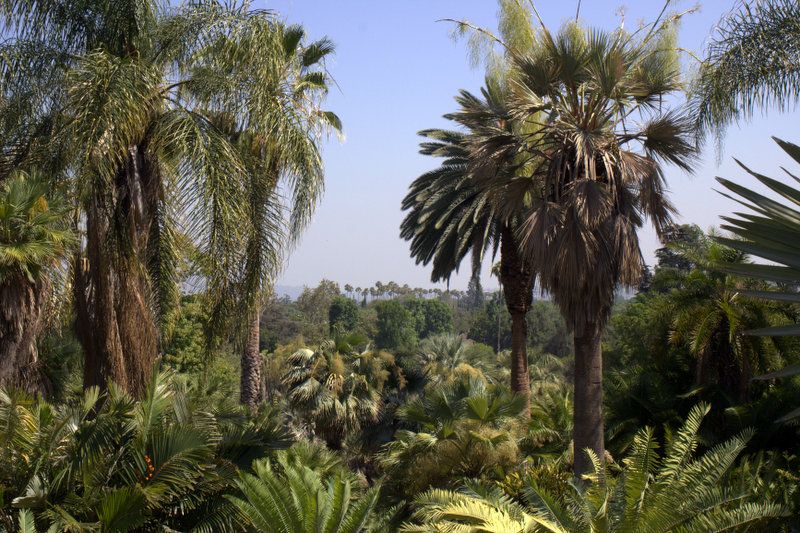
After checking out the CSSA sale at the Huntington recently, per usual, I roamed around the botanical gardens for a while, clutching my little box with the newly acquired Euphorbia clavigera. I must have juggled that euphorbia and my camera for a good, sweaty couple hours at least. And this time I forced myself to head into a section I rarely visit.
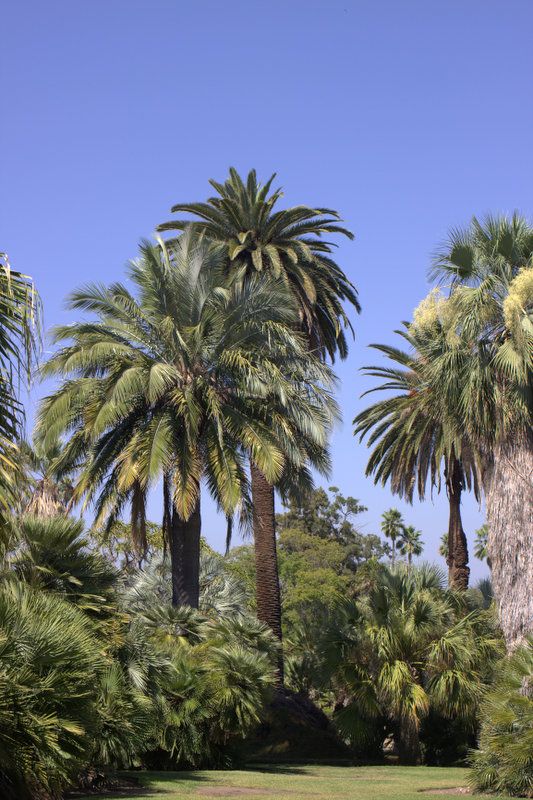
Right up there with oleanders and bougainvillea, palms are a group of mostly non-native plants I’ve managed to take for granted all my life. I’ve been constantly surrounded by all three since birth, so they are about as exotic to me as mown grass. If only I’d explored it sooner, because the Huntington’s collection is a surefire remedy to lifelong palm fatigue.
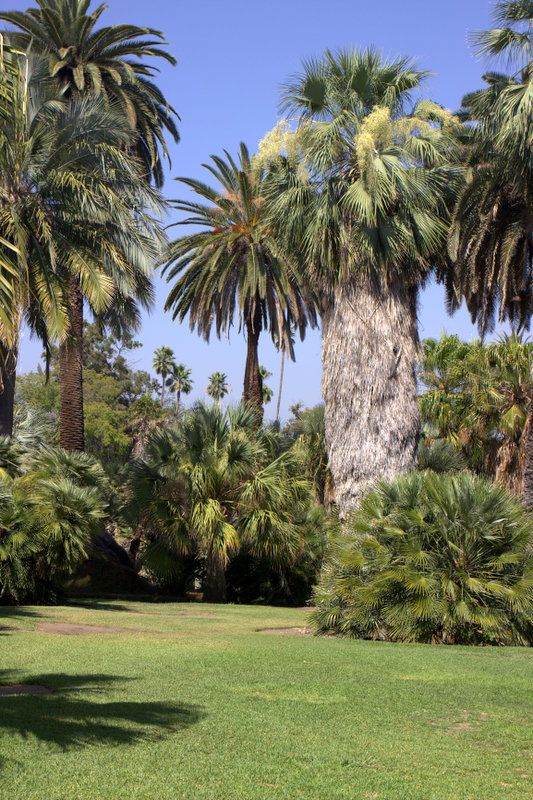
As a kid I walked to school among the shadeless trunks of palm trees like an ant threading through the legs of a herd of elephants, never grasping the totality of the soaring creatures overhead. All these years later, and now that they’re aging out of their lives as street trees, I’m starting to look at them with new eyes. I suppose the timing might have something to do with how I’m less conflicted about living in Los Angeles, shedding my youthful “It’s Chinatown, Jake,” noirish pessimism. I get it now, that these are living post cards from the land on permanent holiday, swaying ambassadors to a life less ordinary. Los Angeles would seemingly be unthinkable without them, but maybe Los Angeles is finally aging out of the old myths and railroad company-driven propaganda too.

Divesting palms of all that la-la-land business, I’ve come to appreciate how remarkable these Los Angeles landmarks truly are. File this turnabout on my part under “you don’t know what you’ve got til it’s gone“: the Los Angeles Department of Water and Power announced in 2006 that they will not be replanting the palms as they come to the end of their approximately 80-year lives (source), or are taken earlier by the dreaded red palm weevil. So now I can look forward to being one of the old geezers who bores kids with stories of when palms lined the streets of Los Angeles.
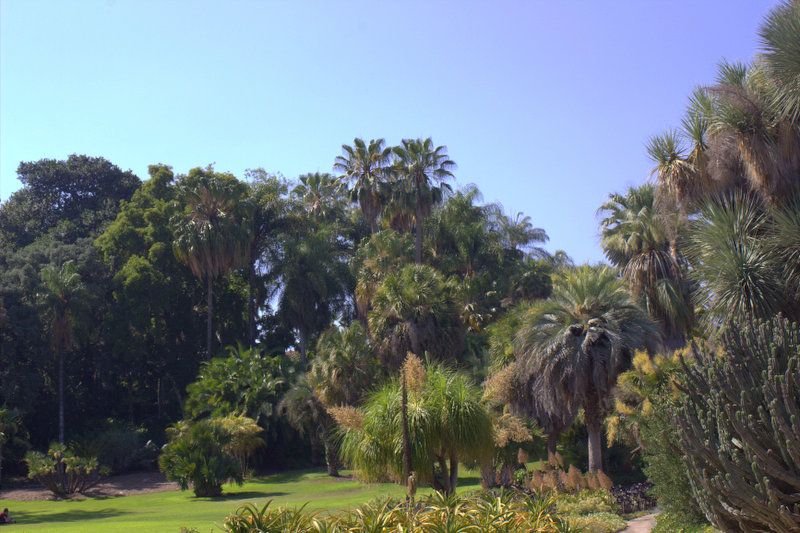
There’s over 2500 species of palms, and the Huntington seemingly has the ambition to have one of each. With the possible exception of the one palm I grow, Dypsis decaryi, the Triangle Palm from Madagascar, you really can’t overwater most palms, though they can and do endure periods of drought. But the one native species’ (Washingtonia filifera) true habitat is riparian, not desert.
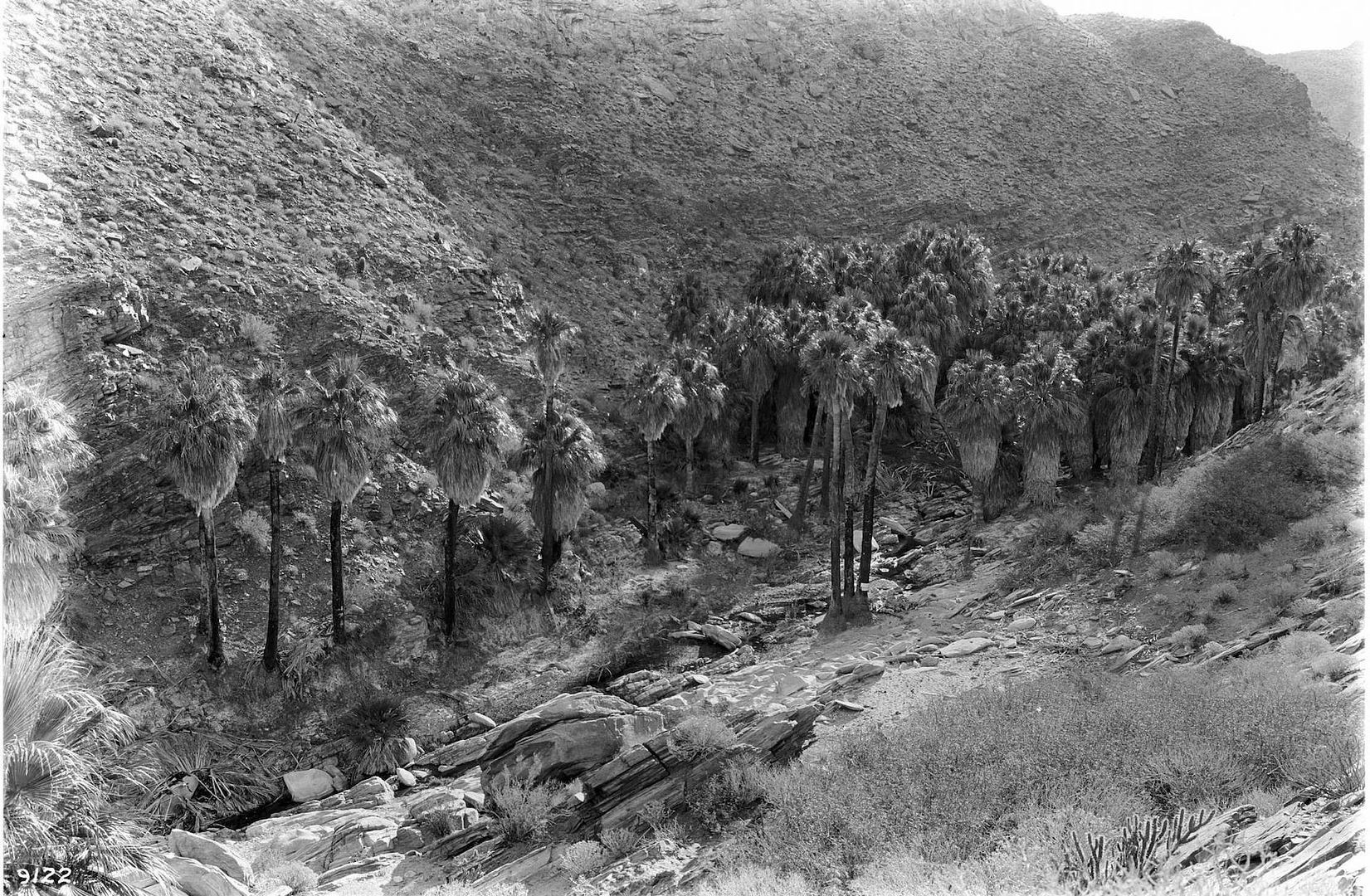
Native Washingtonia filifera palms growing in an oasis near Palm Springs, circa 1900. Courtesy of the USC Libraries – California Historical Society Collection.
“Southern California’s native palms grow far away from Los Angeles, in spring-fed Colorado Desert oases tucked deep inside steep mountain ravines. Centuries before palms were cultivated for their horticultural value, the Cahuilla Indians used these Washingtonia filifera as a natural resource, eating the fruit and weaving the fronds into baskets and roofing.” — KCET “Lost LA”
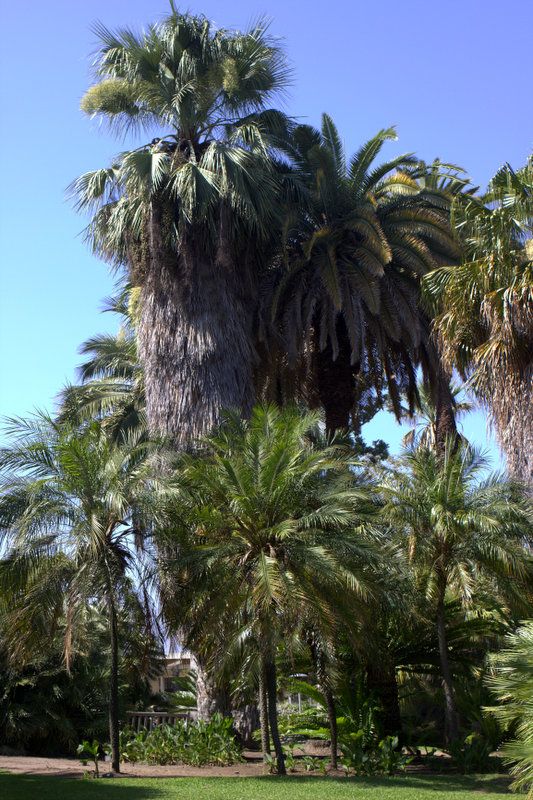
Palms on my street are fruiting now. Every summer I need to become re-accustomed to the loud thonk as the fruit slams onto parked cars. (Did you hear that? Oh, yeah, right, the palms.) And the flies. My god, the flies swarming over the fallen fruit. With the coming of the swarms of flies, neighbors ponder again the unjust allotment of tree trimmers to fancier neighborhoods to cut down the fruiting trusses before they fall. Living underneath palms is not an exercise in nostalgia but pure exasperation. And raking. Lots of raking. Because of the mess and lack of shade, palms offer little else of utility than that iconic profile. But we could argue selection of the perfect street tree all day, right?
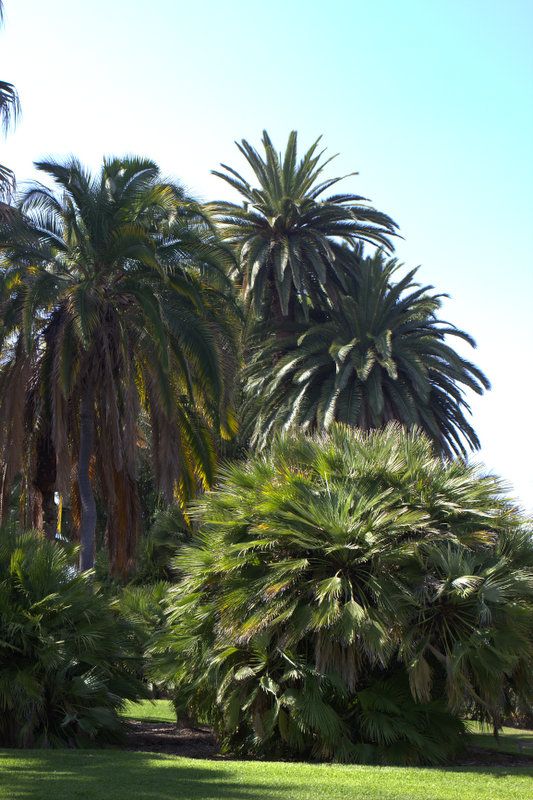
When our neighborhood received a grant to plant street trees some years back, the tree gifted to us was the Australian Brisbane Box, Lophostemon confertus. But there are still a handful of palms interspersed among the newcomers. If I were to add another palm to my garden, it would be the steely blue Bismarckia nobilis or Brahea armata. It kills me that a nearby commercial property for sale has a gorgeous stand of Brahea armata within their chain-linked premises that have gone unwatered for months now, maybe as long as a year, and they are showing the neglect. Some guerrilla palm rescue intervention is needed there.
You can read more about “Palms in Twilight,” the effects of fusarium wilt and Las Vegas driving up prices, by the incomparable Emily Green here.
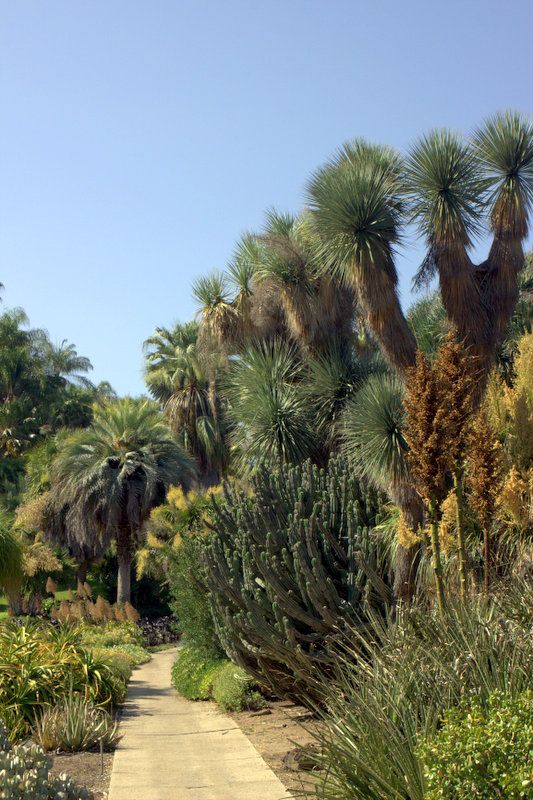
Of course, even at the Huntington they’re not just confined to the palm garden. Look up and out, and you’ll see a palm somewhere in Los Angeles. For now.

I did the same thing last time I was at the Huntington – the palms are a lot cooler than I usually give them credit for. LA without palms really wouldn’t be the same… Even in the desert people try to grow them for the SoCal look!
Strange isn’t it how the palm, a plant of the desert oases, became the iconic tree for Los Angeles? You see it when you are driving the freeways and when you are flying low preparing to land at LAX. I used to hate them until my neighbor took his down. I then realized that it was a sentinel on the hill which I could see for miles around beckoning me home, that it was the nest of the barn owls or flickers on the trunk, that it was a weather sign when the wind changed I could hear the sea breeze or a winter storm coming in from the different sounds of the fronds. Near the northwest corner of California and Orange Grove in Pasadena there are both kinds growing together, the skinny Mexican fan palm ‘sky duster’ and the more robust California fan palm.
What a nice ode to the ubiquitous palms! My mother hated the palms that surrounded the house I grew up in in the San Fernando Valley. Some years after I’d moved out, she sold the palm that stood at the front of the house; however, through the end of her life, she continued to bemoan the presence of the ominously tall palms on the neighbor’s property behind her, which were never maintained and dropped huge fronds on her roof and backyard whenever the Santa Anas blew. Her animosity toward the trees must have been transmitted to me in infancy because I’ve never warmed up to them either. Still, it’s sad to think they’re on the way out.
Well yes, I hated every palm unless I had guests from the midwest who had never seen one in person and were swooning over them. My grandmother lived in the desert , and date palms were part of life. I also hated dates,date shakes, and Indio.
@Renee, for me it’s a rare visit to the Huntington that isn’t mostly spent on the desert garden. I really need to branch out!
@Jane, yes, the wildlife! We watched a nest of crows in a nearby Mexican fan palm, and were amazed at the winds they endured — both the tree and the crows!
@Kris, my mom feels the same way about the palm outside her door. What a bunch of killjoys we are!
@Kathy, that’s one delicacy I’ve yet to try, the date shake!
I know exactly which commercial property you are talking about! I drive by it every day and it kills me! I think about what the cost must have been to put them in. Wish someone would water them too!
I suspect love of palms is more of a,masculine preference, but even so, I am always amazed at how much hatred there can be for palms. I opulent really like a Mexican Fan Palm in my own garden, but love them as skyline and Boulevard palms. Hard to conceive of a Los Angeles without all those palms, but insect pests and diseases may take them out faster than old age. From the height of even older Washingtonia robusta and Phoenix canariensis palms I saw in the Alcazar in Seville, I also think the potential life spans quoted are an underestimate.
Most excellent thoughts on palms.
I have a friend, a native of Butte, Montana, whose first goal on her first trip to California was to see a palm tree. “How far of a drive will it be to see one?” she asked. “Will we be able to get close enough to touch them?” She was amazed by them. We were amazed by her amazement.
It is the San Diego garden blogs, few though they are, that enlighten someone like me who grew up with nasty Washingtonias there indeed exist beautiful palms worth growing.
How did we end up with the worst palm, and the worst Eucalyptus?